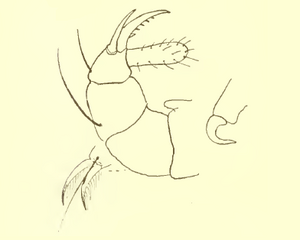Paratarsotomus macropalpis facts for kids
Paratarsotomus macropalpis is a tiny type of mite. It belongs to a family called Anystidae. This mite lives only in Southern California. You can often spot it zipping around on sidewalks and in rocky places. It's super small, about 0.7 millimeters long. That's less than a millimeter! But don't let its size fool you. This mite holds the record for the fastest land animal on Earth, when you compare its speed to its body length!
Quick facts for kids Paratarsotomus macropalpis |
|
|---|---|
 |
|
| Details of a large palp (centre), which is the species' distinguishing feature. Also shown are a tarsal claw (right) and the mandibles (bottom left). | |
| Scientific classification | |
| Kingdom: | |
| Phylum: | |
| Class: | |
| Subclass: | |
| Order: |
Trombidiformes
|
| Family: |
Anystidae
|
| Genus: |
Paratarsotomus
|
| Species: |
P. macropalpis
|
| Binomial name | |
| Paratarsotomus macropalpis (Banks, 1916)
|
|
Contents
Discovering the Speedy Mite
The first Paratarsotomus macropalpis mite was found by William A. Hilton. He collected it from under some stones in Claremont, California.
In 1916, Nathan Banks studied and named this mite. He first called it Tarsotomus macropalpis. Later, in 1999, scientists reclassified it. They moved it and four other species into a new group called Paratarsotomus.
The World's Fastest Animal (Relative to Size)
This amazing mite has been recorded moving incredibly fast. It can reach a speed of 322 body lengths per second! To give you an idea, that's like a human running at 1,300 miles per hour (2,100 km/h)!
Comparing Speeds
- The previous record holder was the Australian tiger beetle (Cicindela eburneola). It's the fastest insect for its size. It could run at 171 body lengths per second.
- The cheetah is the fastest land animal overall. It runs at about 64 miles per hour (103 km/h). But compared to its body length, it only reaches 16 body lengths per second. The mite is much faster relative to its size!
How They Measured the Speed
Scientists used special high-speed cameras to record the mite's movements. They watched the mites both in their natural outdoor environment and in a lab.
Surprising Discoveries
Researchers were amazed by two things about these mites:
- Their incredible speed.
- Their ability to run so fast on hot concrete. The concrete was sometimes as hot as 140°F (60°C)! This temperature is usually deadly for most animals.
The mites can also stop and change direction very, very quickly.
Impact on Science
This discovery helps scientists learn more about how animals move. It pushes the limits of what we thought was possible for living creatures. This finding is important for designing new robots. It also helps in a field called biomimetics, which is about creating new technologies inspired by nature.
See also
 In Spanish: Paratarsotomus macropalpis para niños
In Spanish: Paratarsotomus macropalpis para niños

